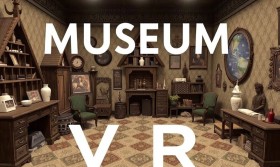Have you ever stood before a complex mechanical clock, listening to the rhythmic tick-tock and watching the intricate dance of gears, and wished you could reach inside to understand its hidden soul? For enthusiasts, historians, and the simply curious, that dream has often felt just out of reach. Traditional museums, with their glass cases and "Do Not Touch" signs, preserve these marvels but can unintentionally create a barrier to true understanding. The Clockwork Museum VR was conceived to shatter that barrier, offering an unprecedented journey into the heart of mechanics. Today, that journey becomes profoundly deeper and more interactive with its latest 'Mechanical Devices' update. This isn't just an addition; it's a transformation of how we interact with the history of invention.
The core philosophy of the Clockwork Museum VR has always been 'Cognition Through Interaction.' It’s one thing to see a static image of a differential gear; it’s an entirely different, enlightening experience to manipulate one yourself and see how it allows a car's wheels to rotate at different speeds. This update doubles down on that principle. We've moved beyond simply showcasing devices to simulating the very physics that make them work. Every gear tooth, every spring coil, and every pendulum swing is now governed by real-world physical properties. This means that if you assemble a device incorrectly, it won't just fail to work—it might jam, grind, or behave in unexpectedly realistic ways, teaching you through failure as much as through success.
Let's step into the new wings of the museum. The first new exhibit is the 'Engineers' Workshop,' a dedicated space that feels less like a gallery and more like Leonardo da Vinci's studio or Nikola Tesla's laboratory. Here, the focus is on the fundamental components that form the language of all machinery. We've introduced a comprehensive library of basic components. This includes not just standard spur gears, but also bevel gears for changing the axis of rotation, worm gears for major speed reduction, ratchets for preventing backward movement, and complex planetary gear systems. You can pick up each component, examine it from every angle, and most importantly, drop it into a dynamic 'sandbox' area to build your own simple contraptions. The goal here is to build an intuitive understanding of how torque is transferred, how speed can be increased or decreased, and how motion can be transformed.

The second major exhibit is the 'Automaton Theater.' This is where mechanics meets art and life. We have meticulously recreated some of history's most famous and complex automatons. You can now witness the 18th-century 'Writer Automaton' by Pierre Jaquet-Droz, a mechanical boy that dips his pen in ink and writes custom sentences on paper. But in our museum, you don't just watch. You can pause the performance, zoom inside the boy's body, and follow the entire sequence of operations. See how a single turn of the mainspring drives a complex series of cams that control every single movement of his wrist and fingers. Another highlight is 'The Digesting Duck' by Jacques de Vaucanson, where you can explore the (admittedly simplified) mechanical illusion that made the duck appear to eat and defecate. This exhibit beautifully demonstrates how mechanical principles were used to create illusions of life, blurring the line between engineering and magic.
Perhaps the most groundbreaking feature of this update is the 'Dynamic Disassembly' mode. For every single device in the museum, from a simple music box to a massive steam engine, you can now activate this mode. With a simple gesture, the device freezes in place. Then, you can carefully remove its components one by one, laying them out in a virtual space exactly as a restorer would in a real workshop. The key enhancement is that the device remains fully functional in this state. As you remove the mainspring from a clock, you can see the gears slow and stop. Reinsert it, and the motion resumes. This allows you to understand the role of every single pin, lever, and gear in the chain of operation, creating a mental map of the machine's functionality that is impossible to achieve with any textbook or video.
To guide your exploration, we have introduced a series of 'Interactive Challenges.' These are structured, puzzle-like experiences designed to test your newfound knowledge. A beginner challenge might ask you to assemble a simple gear train to achieve a specific output speed. An intermediate challenge could involve repairing a broken escapement mechanism in a grandfather clock, requiring you to identify the worn-out part from a selection and correctly install it. The most advanced challenges, however, are truly demanding. One scenario presents you with the schematic for Babbage's Difference Engine and a box of components. Your task is to assemble a small, functional section of it. These challenges provide a tangible goal and a tremendous sense of accomplishment, solidifying theoretical knowledge through practical application.
We understand that the world of mechanics can be daunting. To ensure this update is accessible to everyone, we have built a robust 'Contextual Guidance System.' This is an optional helper that you can toggle on or off. When active, it provides subtle visual and textual cues. Hovering over a component might highlight its name and primary function. If you're struggling with a challenge, the system can offer a hint, such as "The drive gear needs to transfer power to a perpendicular axis," suggesting you might need a bevel gear. Furthermore, we have integrated short, narrated documentary clips from historians and engineers at key points. These aren't dry lectures; they are stories about the inventors, the historical problems they were trying to solve, and the impact of their creations, placing the cold machinery in a rich, human context.

The potential applications of this updated virtual museum extend far beyond casual curiosity. We are already seeing educators design virtual lab sessions where students learn about kinematics without the cost of physical kits. Hobbyists and modern clockmakers are using the disassembly mode to study rare devices they would otherwise never have access to. For parents and children, it becomes a collaborative playground of discovery, turning complex concepts into a shared, enjoyable game. The museum is no longer a passive repository; it is an active, global classroom and workshop.
Ultimately, the 'Mechanical Devices' update for the Clockwork Museum VR is about connection. It connects us to the tangible logic of the physical world in an increasingly digital age. It connects us to the brilliant minds of the past who, with limited tools and boundless imagination, built the foundations of our modern world. And it connects curiosity to understanding, transforming a passive "What is that?" into an active, confident "I see how that works." So, we invite you to put on your headset, step into our expanded halls, and get your hands digitally dirty. Reach into the clockwork, feel the satisfying click of gears meshing, and experience the joy of making the machine come alive under your own guidance. The story of mechanics is waiting, and now, you are not just a reader, but a co-author.


















